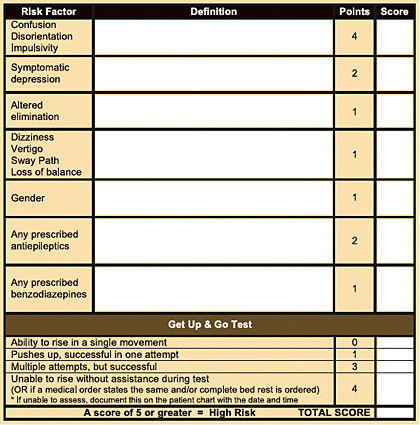 |
 |
 |

May / June 2006

Inpatient Falls:
Lessons from the Field
By Ann Hendrich, MS, RN, FAAN
Preventing patient falls and related injuries in acute care settings has been an elusive goal for many hospitals. Falls are a high-risk and high-cost problem (human and fiscal) for all healthcare facilities. An estimated 30% of hospital-based falls result in serious injury (Stevens, 2004). Several factors have contributed to the complexity of sustaining true fall reduction and the avoidance of harm and injuries. An aging population, rising patient acuity, nurse shortages, and an inefficient work environment for caregivers can make any process improvement a challenge. Leadership plays an instrumental role in understanding the problem, establishing a safety climate culture, and improving the work environment of caregivers so that much needed direct nursing time for patient care can be increased.
Successful fall prevention programs have measurable attributes, which include:
- research-based risk factors that are applied at the unit of care,

- consistent attention to environmental hazards for all patients,

- nursing and medical interventions aligned with reduction of fall risk factors for individual patients,

- continuous learning about unit-specific fall occurrences derived from "good fall data," and

- effective communication of patient risk and teamwork among caregivers and across units — no matter where the patient is in the hospital.
The literature describes a multitude of patient-fall risk factors, but only a few have been statistically validated from randomized, case-control, prospective studies. Prospective descriptive studies of inpatient falls contribute to the general knowledge of fallers but may over-target fall risk when controls (non-fallers) are not considered (Morse, 1997; Watson, 1994; Gluck, 1996; Oliver, 1997; Mendelson, 1996; Hitcho, et. al., 2004).
Many hospitals continue to use "home grown" lists of risk factors that have little scientific basis. Over time, the list of hospital-based risk factors often grows long, based on personal observations and opinions, and caregivers may feel overwhelmed. An exhaustive list that is not research-based may designate every patient as "high risk" for falling. Many of these lists have not been compared and statistically adjusted for suspected risk factors. It is necessary to measure risk factors in both fall patients and control patients who had same or similar risk factors but did not fall. This is the first step in identifying true risk factors versus suspected risk factors. For example, many risk-factor tools continue to use age as a discrete risk factor when age alone does not predict fall potential for an individual. There are just as many 70-year-olds who play golf and swim each day as those who fall. Age appears to be a risk factor because it is often correlated with the true risk factor of altered or ineffective gait and mobility (Hendrich, 1992; Hendrich, Nyhuis, Kippenbrock, & Soja, 2003).
Polypharmacy (more than six drugs) is a prevalent problem in American healthcare that contributes to fall risk. When individual drugs are added to risk factor assessments, over-targeting of fall risk can occur because side effects of drugs are very patient specific and highly variable. Extensive lists of drugs as part of a fall risk-factor assessment is one of the most common reasons for poor program compliance and staff dissatisfaction. The most common side effects of medications (especially in the elderly) include confusion/disorientation, altered elimination needs, dizziness/vertigo, and changes in gait and mobility. Two categories of drugs—benzodiazepines and antiepileptics—in and of themselves do cause an increased risk of falling and should be included in fall risk assessment when weighted risk factors are used (Hendrich, Bender & Nyhuis, 2003). Individuals react differently to medications; while it is crucial the caregiver knows the drug regimen, it may well be more effective to assess and predict fall risk based on the presence of drug side effects exhibited by the patient than by scoring the patient based on the drug alone.
No matter what tool is selected, it should be specific and sensitive to the population being screened and become part of professional nursing practice. The basic nursing assessment contains most if not all of the information needed to assess known risk factors before falls occur. Treating a fall risk assessment as an integrated component of an individual care plan is the first best step for proactive prevention of falls (Figure 1). Too often, fall prevention strategies begin after a fall occurrence, not before. This is a key reason why some fall programs fail to consistently reduce the overall fall index/injury rate over time. A reactionary fall program is one that depends upon a fall to signal reduction strategies instead of proactively seeking to reduce individual patient fall risk factors.


|
 |
 |
 |


















|
 |



